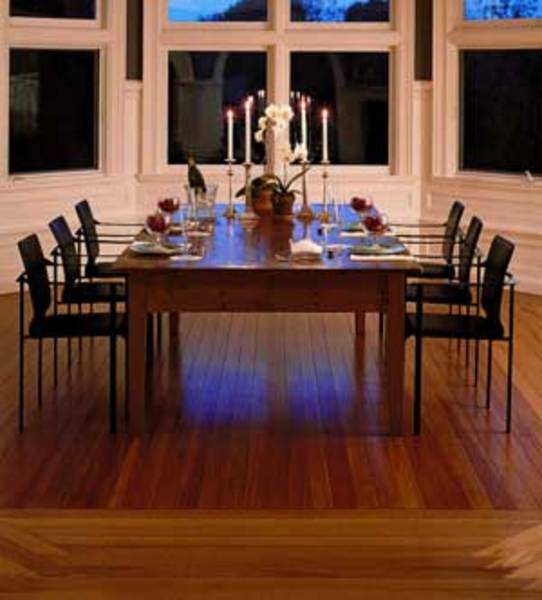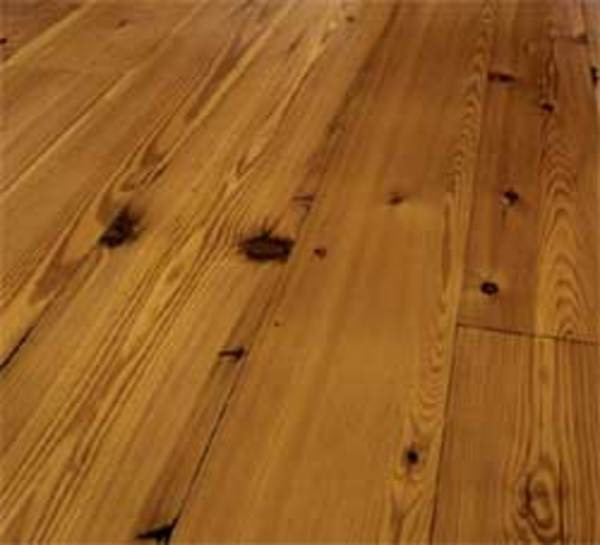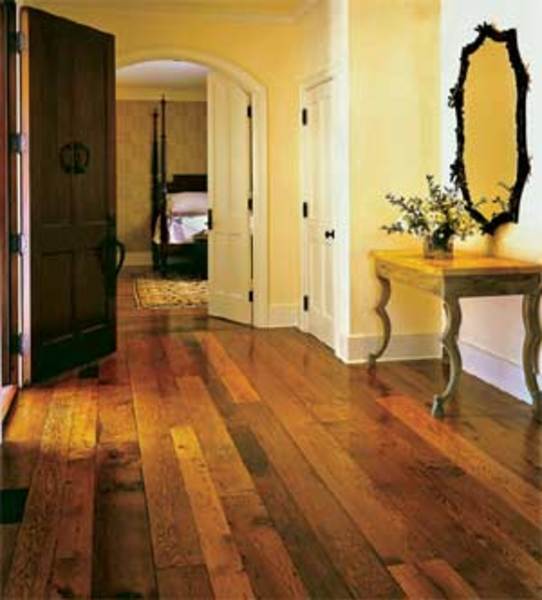
Interior designer Robert Currie specified restoration, not replacement, for an old wood floor in this elegant Shingle Style house in New England. (Photo: Brian Vanden Brink)
You’ve painted the ceiling and papered the walls. The woodwork gleams, the lighting fixtures shine . . . now, with everything else done, the old hardwood floors look dirty.
Although it’s true that few things spruce up a room like a freshly sanded and varnished floor (or a new floor), there are several arguments to be made for not refinishing, at least without forethought. Aside from the expense and the dust—and you have no idea what it’s like until you’ve lived through a floor sanding—you may find the floor has fewer lives than you expected.
Sander, Spare Thy Drum (Belt)
Most old hardwood floors (from the mid-19th century onwards) are connected via interlocking edges called tongue and groove, a laying method that minimizes gaps and keeps the faces of the floorboards from cupping. The upper and lower tabs are about 1/4” thick, and can withstand only two or three sandings before they start splintering, ruining the appearance of the floor. If your floor has already been sanded once or twice in its history, especially by someone a bit too enthusiastic with the sander, you will need to take great care to preserve the floor as you refinish it.

Reclaimed heart pine flooring from Carlisle Wide Plank Floors
That’s true, too, with oak carpet, an alternative to tongue-and-groove popular from about 1880 to 1920. This is a hardwood veneer applied over lower-grade pine flooring (originally meant to be carpeted). The strips of flooring tend to be quite narrow (typically 1 ¼ to 1 ½ inches wide). They are face-nailed, meaning they are not tongue and groove, but simply tacked down with finish nails into the joists. Nail holes that appear uniformly every 16” indicate oak carpet. This finish flooring was milled at just ½” thick, so once again, it can handle only a couple of sandings.
Is there an alternative to sanding that lets you restore the floor? Sometimes, rather than sanding off the old finish and with it some of the floor surface, an otherwise-sound wood floor can be lightly abraded—scratch-sanded or screened—to permit application of a compatible finish. You’ll get a floor that’s not bad and certainly better and more protected than before.
Repairing Simple Wear and Tear
If there’s limited damage to one area of an otherwise good floor, judicious patching can save it. Too much, of course, results in a patchwork effect—and it will test the skill of the carpenter trying to match new wood to old. Sound old wood can be moved to prominent areas, and the patches done in dark corners or under rugs and furniture. Matching wood can be salvaged from closet or attic. Whether you will be happy with a patched floor depends on your “compulsive meter.” If you must have perfection (and frankly, if you must, you shouldn’t be living in an old house), a patched and refinished old hardwood floor may bother you.

Remilled chestnut flooring, popular in some regions and no longer available as new growth (Photo: Chestnut Specialists)
Refinishing Old Hardwood Floors
If a floor is scratch-sanded or screened (not entirely stripped of its old finish), then you must use a compatible finish for reapplication. Most likely this will be an oil-based varnish or oil-based polyurethane. New wood may be sealed with a water-based finish or penetrating oil, or time-honored shellac in non-wet rooms. Every finish has its own attributes regarding shine, longevity, and abrasion-resistance.
The Newly Floored
Sometimes you have to start fresh. Maybe there’s rot, all-over splintering, too many patches, huge gaps, or urine stains. Maybe there was never a finish floor in the first place. Owners of pre-1850 houses who prefer the informal appearance of wide pine often choose reclaimed lumber. It is considered “greener” because it doesn’t involve newly felled old-growth trees; it may be less expensive; it has character to match the truly old house, due to markings made by previous joinery, nails, and wear. Victorian and later homes usually are better suited to hardwoods. Remember that hardwoods may have been used in public rooms, softwood upstairs, and “deal” (usually, butt-jointed wide boards of soft pine or fir) in back halls and attics.
View all Flooring in the Products & Services Directory.







